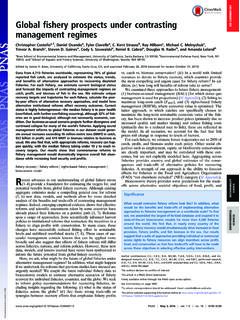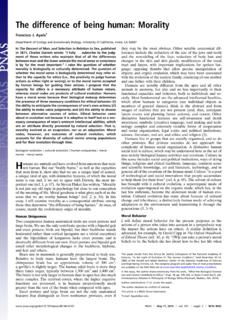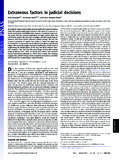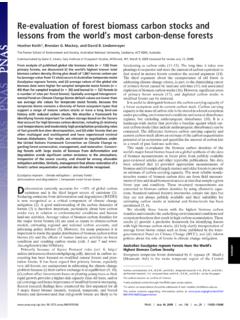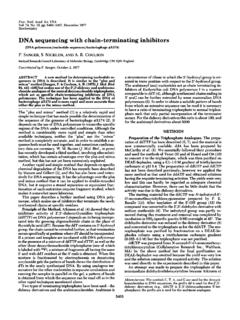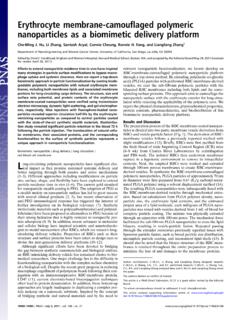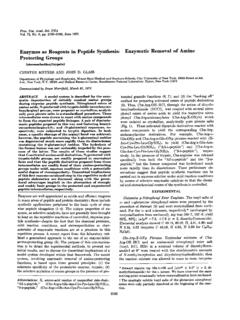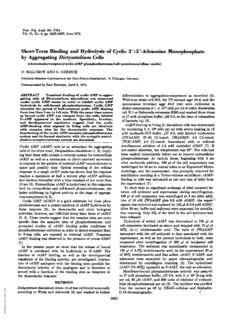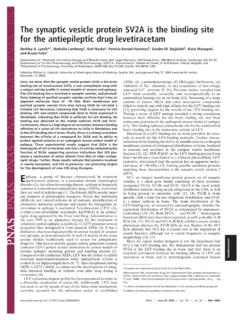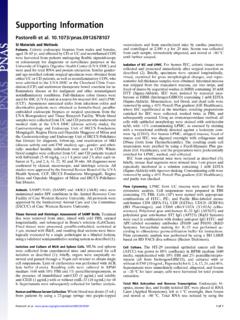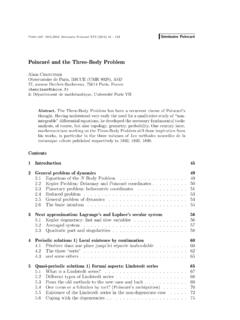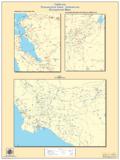Transcription of Bodily maps of emotions - pnas.org
1 Bodily maps of emotionsLauri Nummenmaaa,b,c,1, Enrico Glereana, Riitta Harib,1, and Jari K. HietanendaDepartment of Biomedical Engineering and Computational Science andbBrain Research Unit, O. V. Lounasmaa Laboratory, School of Science, AaltoUniversity, FI-00076, Espoo, Finland;cTurku PET Centre, University of Turku, FI-20521, Turku, Finland; anddHuman Information Processing Laboratory, Schoolof Social Sciences and Humanities, University of Tampere, FI-33014, Tampere, FinlandContributed by Riitta Hari, November 27, 2013 (sent for review June 11, 2013) emotions are often felt in the body, and somatosensory feedbackhas been proposed to trigger conscious emotional we reveal maps of Bodily sensations associated with differentemotions using a unique topographical self-report method. In fiveexperiments, participants (n=701) were shown two silhouettes ofbodies alongside emotional words, stories, movies, or facial expres-sions. They were asked to color the Bodily regions whose activitythey felt increasing or decreasing while viewing each emotions were consistently associated with statisticallyseparable Bodily sensation maps across experiments.
2 These mapswere concordant across West European and East Asian classifiers distinguished emotion-specific activation mapsaccurately, confirming independence of topographies across emo-tions. We propose that emotions are represented in the somatosen-sory system as culturally universal categorical somatotopic of these emotion-triggered Bodily changes may playa key role in generating consciously felt |feelings|somatosensationWe often experience emotions directly in the body. Whenstrolling through the park to meet with our sweetheart wewalk lightly with our hearts pounding with excitement, whereasanxiety might tighten our muscles and make our hands sweat andtremble before an important job interview. Numerous studieshave established that emotion systems prepare us to meet chal-lenges encountered in the environment by adjusting the activa-tion of the cardiovascular, skeletomuscular, neuroendocrine, andautonomic nervous system (ANS) (1). This link between emo-tions and Bodily states is also reflected in the way we speak ofemotions (2): a young bride getting married next week maysuddenly have cold feet, severely disappointed lovers may be heartbroken, and our favorite song may send a shiver downour spine.
3 Both classic (3) and more recent (4, 5) models of emotionalprocessing assume that subjective emotional feelings are trig-gered by the perception of emotion-related Bodily states thatreflect changes in the skeletomuscular, neuroendocrine, and auto-nomic nervous systems (1). These conscious feelings help theindividuals to voluntarily fine-tune their behavior to better matchthe challenges of the environment (6). Although emotions areassociated with a broad range of physiological changes (1, 7), it isstill hotly debated whether the Bodily changes associated withdifferent emotions are specific enough to serve as the basis fordiscrete emotional feelings, such as anger, fear, or happiness(8, 9), and the topographical distribution of the emotion-relatedbodily sensations has remained we reveal maps of Bodily sensations associated with dif-ferent emotions using a unique computer-based, topographicalself-report method (emBODY, Fig. 1). Participants (n=701) wereshown two silhouettes of bodies alongside emotional words,stories, movies, or facial expressions, and they were asked tocolor the Bodily regions whose activity they felt to be increased ordecreased during viewing of each stimulus.
4 Different emotionswere associated with statistically clearly separable Bodily sensa-tion maps (BSMs) that were consistent across West European(Finnish and Swedish) and East Asian (Taiwanese) samples, allspeaking their respective languages. Statistical classifiers dis-criminated emotion-specific activation maps accurately, confirmingindependence of Bodily topographies across emotions . We pro-pose that consciously felt emotions are associated with culturallyuniversal, topographically distinct Bodily sensations that maysupport the categorical experience of different ran five experiments, with 36 302 participants in each. Inexperiment 1, participants reported Bodily sensations associatedwith six basic and seven nonbasic ( complex ) emotions , aswell as a neutral state, all described by the corresponding emo-tion words. Fig. 2 shows the Bodily sensation maps associatedwith each emotion. One-out linear discriminant analysis (LDA)classified each of the basic emotions and the neutral state againstall of the other emotions with a mean accuracy of 72% (chancelevel 50%), whereas complete classification (discriminating allemotions from each other) was accomplished with a mean ac-curacy of 38% (chance level 14%) (Fig.)
5 3 andTable S1). Fornonbasic emotions , the corresponding accuracies were 72% and36%. When classifying all 13 emotions and a neutral emotionalstate, the accuracies were 72% and 24% against 50% and 7%chance levels, respectively. In cluster analysis (Fig. 4,Upper), thepositive emotions (happiness, love, and pride) formed one cluster,whereas negative emotions diverged into four clusters (anger andfear; anxiety and shame; sadness and depression; and disgust,contempt, and envy). Surprise neither a negative nor a positiveemotion belonged to the last cluster, whereas the neutralemotional state remained distinct from all other controlled for linguistic confounds of figurative languageassociated with emotions ( , heartache ) in a control exper-iment with native speakers of Swedish, which as a Germaniclanguage, belongs to a different family of languages than Finnish(a Uralic language). BSMs associated with each basic emotionword were similar across the Swedish- and Finnish-speakingsamples (meanrs= ), and correlations between mismatchedemotions across the two experiments ( , anger-Finnish coordinate our behavior and physiological states duringsurvival-salient events and pleasurable interactions.
6 Even thoughwe are often consciously aware of our current emotional state,such as anger or happiness, the mechanisms giving rise to thesesubjective sensations have remained unresolved. Here we useda topographical self-report tool to reveal that different emo-tional states are associated with topographically distinct andculturally universal Bodily sensations; these sensations couldunderlie our conscious emotional experiences. Monitoring thetopography of emotion-triggered Bodily sensations brings fortha unique tool for emotion research and could even provide abiomarker for emotional contributions: , , , and designed research; and per-formed research; and contributed new reagents/analytic tools; and data; and , , , and wrote the authors declare no conflict of available online through the pnas open access whom correspondence may be addressed. E-mail: or article contains supporting information online Early Edition|1of6 PSYCHOLOGICAL ANDCOGNITIVE SCIENCES happiness-Swedish) were significantly lower (meanrs= )than those for matching test whether the emotional Bodily sensations reflect culturallyuniversal sensation patterns vs.
7 Specific conceptual associationsbetween emotions and corresponding Bodily changes in WestEuropean cultures, we conducted another control experiment withTaiwanese individuals, who have a different cultural background(Finnish: West European; Taiwanese: East Asian) and speakUse the pictures below to indicate the Bodily sensations you experience when you feel For this body, please color the regions whose activity becomes stronger or faster SADNESS For this body, please color the regions whose activity becomes weaker or slower CLICK HERE WHEN FINISHED Initial screen with blank bodies Subject-wise colored activation and deactivation maps Subject-wise combined activation-deactivation map Random effects analysis and statistical inference Activations Deactivations ABCFig. Participants colored theinitially blank body regions (A) whose activity theyfelt increasing (left body) and decreasing (rightbody) during emotions . Subjectwise activation deactivation data (B) were stored as integers, withthe whole body being represented by 50,364 datapoints.
8 Activation and deactivation maps were sub-sequently combined (C) for statistical ContemptPrideShameEnvy15-150105-10-5 Fig. topography of basic (Upper) and nonbasic (Lower) emotions associated with words. The body maps show regions whose activation increased(warm colors) or decreased (cool colors) when feeling each emotion. (P< FDR corrected;t> ). The colorbar indicates thet-statistic | et language belonging to a family of languages distant from Finnish(Taiwanese Hokkien: Chinese language). Supporting the culturaluniversality hypothesis, BSMs associated with each basic emo-tion were similar across the West European and East Asiansamples (meanrs= ), and correlations between mismatchedemotions across the two experiments ( , anger-Finnish ) were significantly lower (meanrs= )than those for matching people recall Bodily sensations associated with emotioncategories described by words, they could just report stereotypesof Bodily responses associated with emotions . To control for thispossibility, we directly induced emotions in participants using twoof the most powerful emotion induction techniques (10, 11) guided mental imagery based on reading short stories (experi-ment 2) and viewing of movies (experiment 3) and asked themto report their Bodily sensations online during the emotion in-duction.
9 We carefully controlled that emotion categories orspecific Bodily sensations were not directly mentioned in thestories or movies, and actual emotional content of the stories(Fig. S1) was evaluated by another group of 72 subjects (see for corresponding data on movies). BSMs were similar tothose obtained in experiment 1 with emotion words (Figs. S2andS3). The LDA accuracy was high (for stories 79% and 48%against 50% and 14% chance levels for one-out and completeclassification and for movies, 76% and 50% against 50% and20% chance levels, respectively). The BSMs were also highlyconcordant across emotion-induction conditions (stories ; meanrs= ;Table S2).Models of embodied emotion posit that we understand others emotions by simulating them in our own bodies (13, 14), meaningthat we should be able to construct Bodily representations ofothers somatovisceral states when observing them expressingspecific emotions . We tested this hypothesis in experiment 4 bypresenting participants with pictures of six basic facial expres-sions without telling them what emotions (if any) the facesreflected and asking them to color BSMs for the persons shownin the pictures, rather than the sensations that viewing theexpressions caused in themselves.
10 Again, statistically separableBSMs were observed for the emotions (Fig. S4), and the classi-fier accuracy was high (70% and 31% against 50% and 14%chance levels for one-out and complete classification schemes,respectively; Fig. 3 andTable S1). Critically, the obtained BSMswere highly consistent (Table S2) with those elicited by emo-tional words (meanrs= ), stories (meanrs= ), andmovies (meanrs= ).If discrete emotional states were associated with distinct pat-terns of experienced Bodily sensations, then one would expectthat observers could also recognize emotions from the BSMs ofothers. In experiment 5, we presented 87 independent partic-ipants the BSMs of each basic emotion from experiment 1 ina paper-and pencil forced-choice recognition test. The partic-ipants performed at a similar level to the LDA, with a 46% meanaccuracy (vs. 14% chance level). Anger (58%), disgust (43%),happiness (22%), sadness (38%), surprise (54%), and the neutralstate (99%) were classified with high accuracy (P< againstchance level in 2test), whereas the performance did not exceedthe chance level for fear (8%, NS).
